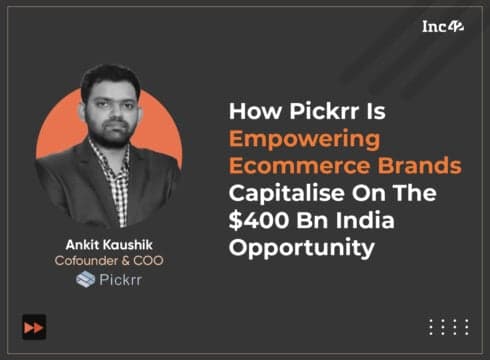3PL players like Pickrr have been a critical driving force behind India’s commerce boom which is set to hit $400 Bn by 2030, growing at a CAGR of 19%
AI-backed Pickrr has grown from 10 brands and 6K shipments per day in 2016 to 50+ brands and 10 Mn shipments per quarter in 2022
Going ahead, ecommerce brands must focus on Tier 2 and 3 locations as the next destinations for big growth, Pickrr’s cofounder and COO Ankit Kaushik says
Inc42 Daily Brief
Stay Ahead With Daily News & Analysis on India’s Tech & Startup Economy
Despite challenges galore in the past couple of years, primarily triggered by the onset of Covid-19, ecommerce boomed for the convenience and safety it offered in a pandemic situation ruled by lockdowns and social distancing.
With the fall of brick-and-mortar stores in Covid years, e-retail became part and parcel of how India shopped, and the momentum has continued since. So much so that Indian ecommerce is estimated to reach a $400 Bn market opportunity by 2030, growing at a CAGR of 19%, according to an Inc42 report.
The rise of online shopping is no India-specific business phenomenon. The pandemic-driven inflexion in e-retail has happened globally. But in India, one of the largest consumer economies, it has been a many-layered growth narrative.
Diving deeper, one will find how third-party logistics (3PL) players like Pickrr and its ilk have been a critical driving force behind the country’s ecommerce spike. Their smart solutions focussing on low pricing, quick and efficient delivery, optimum inventory management and transparent operations are vital to the long-term success of consumer brands and ecommerce platforms.
“Pickrr, with its customer-centric approach and AI-powered logistics solutions, helps ecommerce brands set up robust supply chains,” said cofounder and COO Ankit Kaushik. “We monitor brands’ CSAT score, NPS and more to optimise their costs so that brands don’t feel the pinch as they scale up,” he emphasised.
For context, the 3PL market is expected to surpass $15 Bn by 2025 from around $7.34 Bn in 2020, growing at a CAGR of 16-18%, as per an Inc42 report.
In a freewheeling chat with Inc42’s Trisha Nayyar, cofounder and COO Ankit Kaushik shares his insights into Pickrr’s journey from launch to acquisition by Shiprocket and the trends and 3PL solutions ecommerce brands must focus on as they chase sustainable growth.
From 10 brands and 6K shipments a day in 2016 to onboarding 50+ brands and fulfilling 10 Mn shipments per quarter in 2022, Pickrr had a remarkable and rewarding journey.
Set up by Rhitiman Majumder, Gaurav Mangla and Ankit Kaushik in 2015, the Gurugram-based logistics startup was acquired by 3PL aggregator Shiprocket in 2022. Pickrr started to script a new growth story after the acquisition and successfully fast-tracked several critical initiatives.
As customer retention is key to sustainable growth, Pickrr and Shiprocket have jointly developed a suite of services as part of a full tech stack to cater to every logistics need of ecommerce brands. These include affordable warehousing, smart inventory management, same-day/next-day deliveries across 29K Indian pin codes and more.
The combined entity also optimised teams to increase efficiency and reduce redundancies in the overall system, the Pickrr COO added.
“We have separated and built different businesses as we try to scale up in India and outside,” he said. “Along with the Shiprocket group of companies like Wigzo, Omuni (and more), it is a complete solution for every logistics problem, be it an online or offline brand.”
Although the onset of the funding winter in 2022 adversely impacted the growth plans of many ecommerce brands within the Indian startup ecosystem, Kaushik wanted them to become resilient.
“Think of it as a sine curve. Currently, there might be a downturn, but the coming years would see an uptick,” he said. “Brands must focus on their retention metrics and boost repeat purchases from existing customers instead of spending more and more on acquiring new ones.”
Going ahead, ecommerce brands must focus on Tier 2 and 3 locations as the next destinations for big growth, Kaushik pointed out.
“Brands must expand deeper in those areas and focus on making deliveries quicker and more efficient. Also, to enhance the overall customer experience across all tiers, brands must facilitate deliveries in one to two days rather than four to five days,” he concluded.
Key Highlights
Funding Highlights
Investment Highlights
Acquisition Highlights
Financial Highlights
Note: We at Inc42 take our ethics very seriously. More information about it can be found here.






